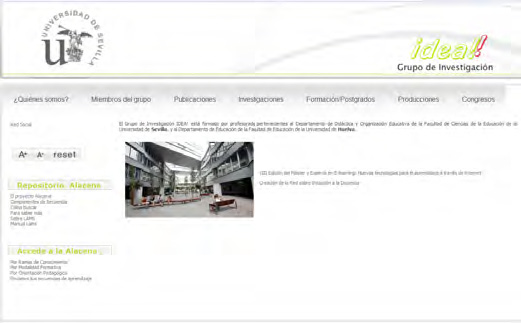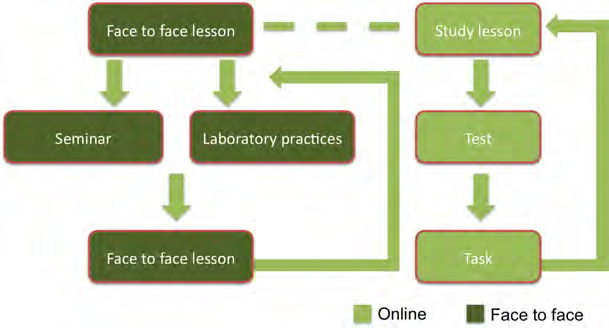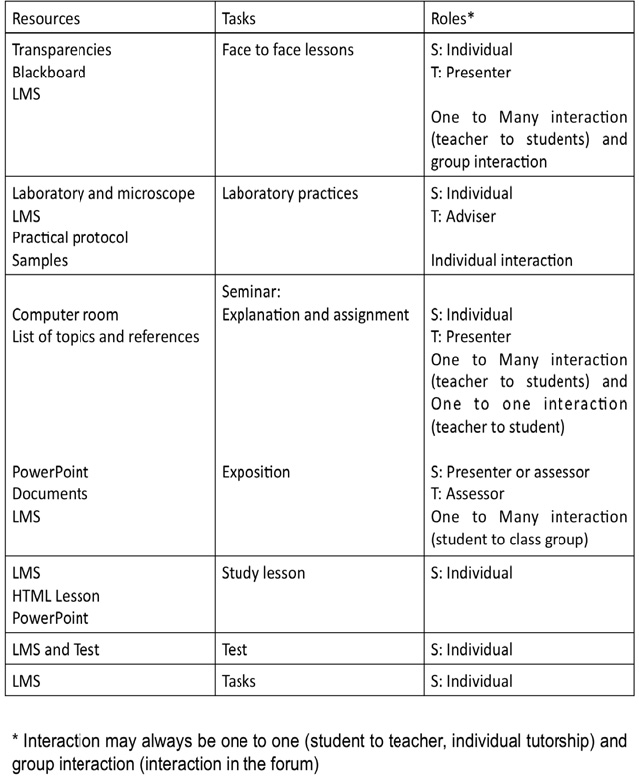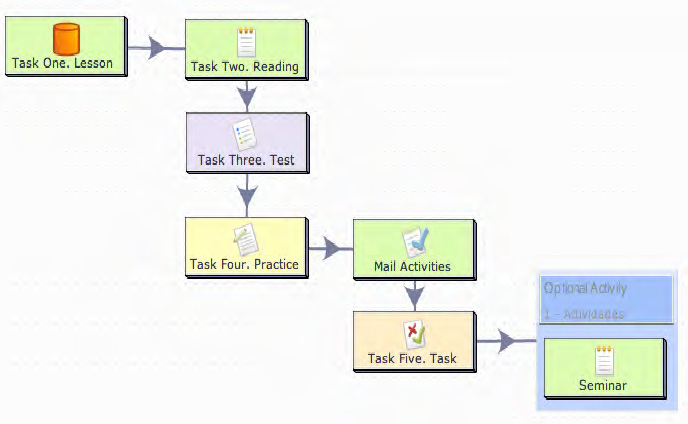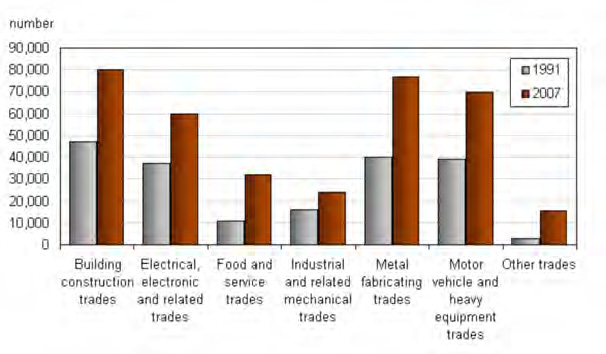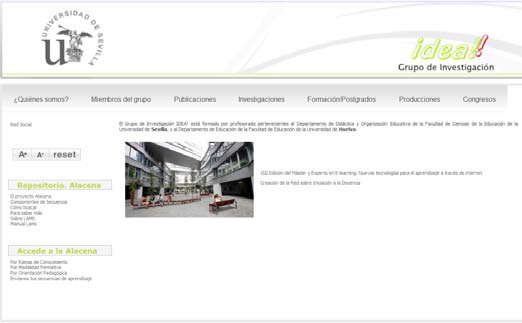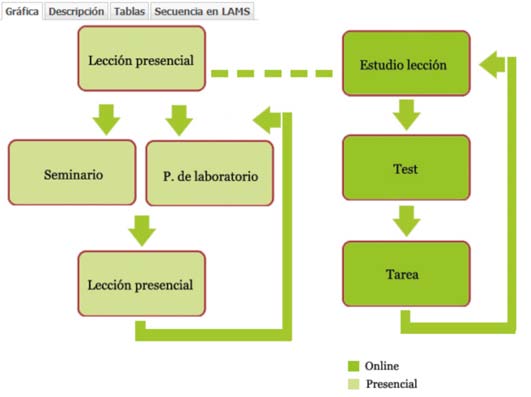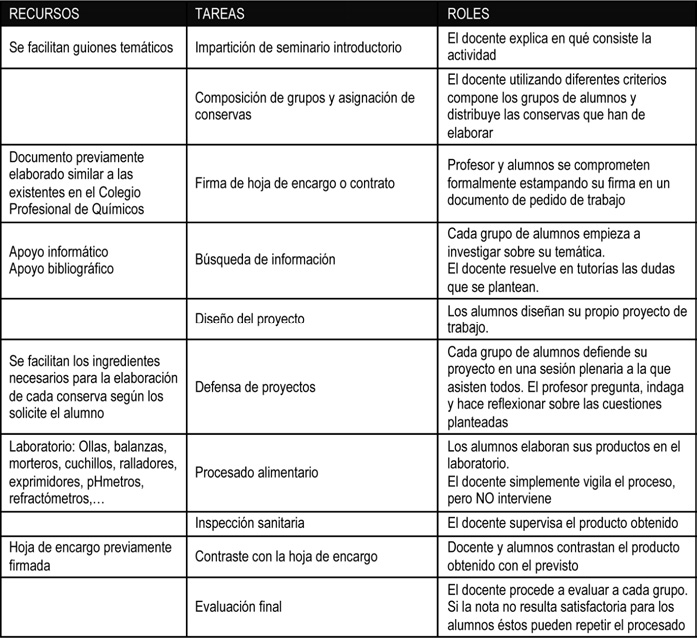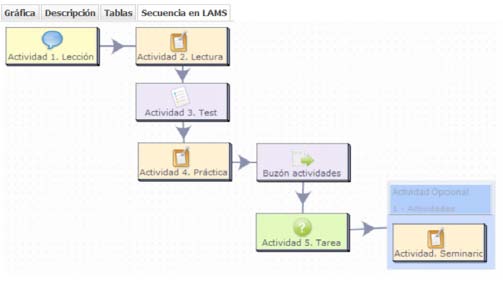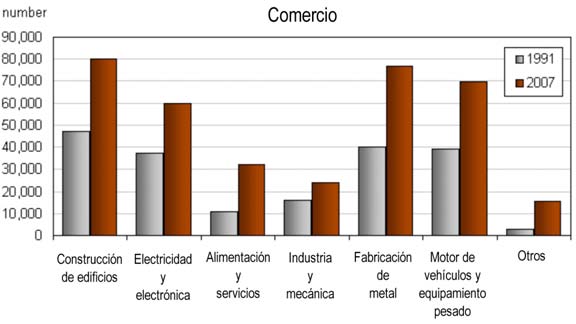Pulsa aquí para ver la versión en Español (ES)
Abstract
Being a teacher means being involved in the design of learning activities. The teaching profession has become a «profession of knowledge», not because knowledge was or is the legitimate component of the profession, but because the teacher is the designer of learning environments and has the ability to design the spaces where knowledge is being produced. But these learning environments have long been regulated to the privacy of the classroom environment with student complicity. One positive aspect of the launch of the European Higher Education Area has been to bring greater transparency to the process of designing teaching and student learning. Our objective in this study was to identify, represent and document a wide variety of learning designs made by experienced and innovative teachers. We hope this repository will be available and accessible to every teacher through the Internet. The participants in this study were 58 teachers mainly from universities in Andalusia and the five branches of knowledge. From interviews we proceeded to represent all the learning sequences, available in the repository of sequences that we named «Ala cena». This repository is accessible on our research group’s website (http://prometeo.us.es/idea). The conclusions of our study were that there are innovative learning designs aimed at promoting a greater understanding of what students learn through their involvement in processes of inquiry and/or collaboration, and they are representative of good teaching practices in universities.
1. Introduction
One of the most evident consequences of the gradual introduction of the European Space of Higher Education is the change in the processes of planning and design of the teaching carried out by university teachers. The emphasis on ensuring the quality of teaching and learning for students is requiring university teachers to anticipate the learning processes in which the students will be involved. The systems to guarantee the quality of new university degrees, as well as the procedures for their verification and future accreditation, demand high levels of transparency from university teachers with regard to the teaching and learning processes that the students will be part of.
In order to encourage autonomous learning, we need to design and promote formative actions that involve the students in active learning (Huber, 2008). From this point of view, the students are the ones who construct their own knowledge through learning activities (Benito Capa & Cruz Chust, 2007) which, in order to maximize the quality of learning results, according to Meyers & Nulty (2009), should be authentic, real and relevant; constructive, sequential and related to each other; require the students to use and participate in progressively more sophisticated cognitive processes; be aligned with the desired learning results, and generate interest and motivation to learn. Herrington, Reeves, Oliver & Woo (2004), influenced by the constructivist theory of education and advances in technology, call these authentic activities.
Being a university teacher means being involved in designing learning tasks. But if learning is now understood not as consumption but as production of knowledge and, consequently, teaching does not transmit knowledge but leads and facilitates it, university teachers should no longer take the role of a leading actor, and should become the set designer instead (Murillo, 2006). This makes us reaffirm, as Bain (2007) points out, that university teachers should think of teaching as the promotion of learning, and should create a critical learning environment that is natural, and where people learn by tackling important, attractive or intriguing problems - authentic tasks that provide them with a challenge when it comes to dealing with new ideas, reconsidering their assumptions and examining their mental models of reality. Along the same lines, Hannafin, Oliver and Land (1999) suggest that suitable learning environments are characterised by the encouragement of student participation in complex cognitive learning activities that include problem solving, critical thinking, collaboration and/or self-adjustment.
Consequently, the didactic planning of a topic or subject should not be limited to distributing the contents throughout a schedule using the European credit system as a calculation system for teaching activity. Instead, the central element of this planning should be to present sequentially the whole set of activities and tasks to be done in order to guide the experiences that the students will have to cover throughout the teaching-learning process (De Miguel, 2006: 17).
Our role as teachers will involve long hours of designing and preparing learning activities and situations or scenarios that allow active and cooperative learning, where the development or execution of the complex actions that constitute each competency take place, rather than preparing and imparting the disciplinary contents of our specialty (De la Cruz Tomé, 2003; Kiss & Castro,2005). It should be remembered that adopting a teaching approach that guides students in their learning also means taking on the role of a facilitator who should respond to the needs of the group and of particular students (Borthwick, Bennett, Lefoe, & Huber, 2007).
In summary, the teaching profession has become a «profession of knowledge», not because knowledge has been or is the validating component of the profession, but because the university teacher is the designer of learning environments and is capable of making the spaces where learning takes place profitable (Marcelo, 2001, Marcelo & Vaillant, 2010). However, for a long time these learning environments have been controlled by the privacy of the classroom and the students’ involvement (Guerra, González & García, 2010). One of the positive effects of the introduction of the European Space of Higher Education has in fact been to make the design processes of the students’ teaching and learning more transparent, as it asks that we, though perhaps too far in advance, inform them of how we are going to ensure that our students acquire competencies by developing what have been called «teaching guides» (Marcelo & Yot, 2010).
1.1. Designing students’ learning
Design is a critical task that is a characteristic of the role of a teacher. As Schön (1990) affirms, professionals design situations in which they apply their tacit knowledge, as well as improvising. Learning design is the human activity in which people outline and plan learning activities, units of learning that a subject must carry out in order to learn (Koper & Tattersall, 2005). As a synonym of instructional design, it involves, according to Horton (2006), selecting, organising and specifying the learning experiences necessary to teach something to someone.
As Cameron (2007) clarifies, the term learning design refers to a general and comprehensive method of description of the teaching-learning process. «Learning design» is a representation of the teaching-learning practice set out in some form of notation through which it can be shared between teachers, replicated by a new teacher or used as a basis in creating new learning activities (Conole, 2008). These forms of representation are defined by Conole (2008) as mediation devices, thus emphasising their role as mediator in terms of how they are used as part of the design of new learning activities and/or to help other university teachers make informed decisions with regard to learning design (Conole, 2007). This leads Masterman, Jameson, & Walker (2009) to question whether the designs should be prescriptive, that is to say, used to communicate to teachers a list of steps to follow, or descriptive in the sense of offering teachers information about what others have done, from which they may be able to discover their own variants.
The idea of using learning designs as a means of sharing good teaching-learning practices is gaining interest. Beetham & Sharpe (2007) provide a valuable description of the current development of this line of investigation by revising the aspects relating to learning design, its exchange and reuse. However, as Falconer & Littlejohn (2006) suggest, a learning design can only be shared if the representation provides all the information that teachers need in order to understand it, often giving details of component elements of each learning activity, such as the learning tasks and the necessary resources and support (Conole, 2008; Oliver, Herrington, Herrington, & Reeves, 2007). In addition, according to Koper (2005), it should provide the means for illustrating the underlying design inherent in each learning practice, which is more widely applicable than the practice itself.
2. Creation of a repository for learning sequences for university teaching
After establishing and highlighting the importance of student learning design in the new context of the European Space of Higher Education, we will describe the investigation we have developed, which has enabled us to design a repository for Learning Sequences. Our objective in this investigation was to identify, represent and document a wide variety of learning sequences planned by university teachers with extensive innovative experience and make them available and accessible through the internet.
2.1. Looking for innovative learning designs
Fifty-eight teachers have participated in this study, from the various universities in Spain as well as from the University of Chile, specifically from the Faculty of Medicine. The largest numbers of teachers are from the University of Seville (23) and the University of Huelva (12).
Of the total of participating university teachers, twenty-four correspond to the branch of Health Sciences, mainly Medicine and Nursing qualifications. In second place are the Architecture and Engineering university teachers with a total of fifteen university teachers participating in the study. There is a smaller presence of university teachers corresponding to Social Sciences (Teaching, Psychology, History…), and to Sciences (Biology, Maths, Chemistry…).
As we have mentioned, the selection of the university teachers was deliberate, since we were interested in having access to university teachers with a strong university career as well as a proven capacity for innovation. In order to choose participants we used various methods, including selecting university teachers participating in teaching innovation projects in Spanish universities, and university teachers who had received prizes for their activity in innovation.
2.2. How did we obtain the information?
The data collection has been carried out through semi-structured individual interviews with each university teacher who was part of our study sample. Once we had identified a university teacher with an outstanding career in teaching innovation, we arranged an interview with them. The purpose of the interview was for the participants to describe a learning sequence that they habitually plan and implement for the development of the subject that they teach, focusing in the activities carried out by the students, the role played by the students and the university teacher, and the resources that are used to support the students’ learning. In the course of the interview we aimed to discover and identify at least the following elements of the learning design:
First Context: competencies to be taught with the sequence, expected learning results, prerequisites for carrying out the sequence, study content covered, time needed to complete it and level of difficulty.
Second the Activities performed by the students and university teachers: tasks that are involved (assimilatory, managing information, adaptive, communicative, productive, experiential, evaluative), type of interaction required (individual or in groups), roles adopted (student as an individual, student as part of a group, advisor, mentor, facilitator, moderator…), necessary resources (demonstrations, texts, audio-visual resources, web pages, email…) and evaluation system (diagnostic, formative, summative).
As interviewers we used an interview guide, with direction on questions to ask, and all the interviews were recorded in audio and had an average duration of approximately 90 minutes, depending on the complexity of each sequence.
Once each of the learning sequences had been reformulated, in separate reports, they were sent to the teachers for them to review and validate the report that had been produced. All the contributions that the university teachers made about the representations of their sequences and their own learning designs were then incorporated.
Following this, all the learning designs were edited in HTML format to be published on the internet and produced with the LAMS tool. The next stage was the creation of the repository on the investigation group’s web page.
Although it is not the purpose of this article, it should be made clear that the study proceeded with a complex process of data analysis. After the reports had been returned and validated, a first analysis was carried out to describe the various learning activities and classify the tasks involved. In order to do this we set out a system of categories. Subsequently, in order to specify the relationships between the learning activities described, and thus to find out what patterns of learning activities were frequent in the totality of the sequences, a second data codification was carried out. The results showed us that patterns of learning activity exist based on the minimal combination or structuring of activities.
3. The result: The Storage Space for Learning Sequences
All fifty-eight learning sequences are available in the sequence depository that we have called Alacena. This repository is available on our investigation group’s web page, as indicated above, http://prometeo.us.es/idea
Since its creation, Alacena has been an open resource available to university teaching staff with the sole purpose of allowing them to find the representation of a variety of highly innovative learning sequences that can help them to effectively design their own courses. Furthermore, it has been conceived as a resource to be permanently constructed and added to, as it receives contributions from those university teachers who choose to share their own experiences. Nevertheless, we are aware that there is not a tradition of making formal plans in education, and in general the design is a very local and even individual aspect (Koper, 2005; Oliver, 2007). For this reason, there follows a detailed description of the notation system, the learning design we have developed, and the authorised uploading tool.
In order to develop the representations of the learning sequences, a standardised design language is required, i.e. a notation that describes the learning design in an interpretable way (Koper & Bennett, 2008). By notation, the system of conventional signs that is adopted to express concepts is understood. A number of attempts are now emerging to comprehensively document learning designs, with the effect that there are currently many types of representation that can serve a wide range of different purposes. As examples of these initiatives, Agostinho (2008) highlights: E2ML, IMS Learning Design, Learning Design Visual Sequence, LDLite, Learning Activity Management System and the design patterns. Richards & Knight (2005), McAndrew, Goodyear & Dalziel (2006), Cameron (2007), and Falconer & al. (2007), have also offered their review of the existing representations.
Our learning design provides all the information that teachers need in order to understand and reproduce any of the learning sequences, giving details of the component elements of each learning activity, such as the learning tasks and the necessary resources and support (Conole, 2008; Oliver, Herrington, Herrington & Reeves, 2007), represented as:
1) An account of general and identification information that can help to contextualise the sequence, such as the qualification, the subject and the student-teacher ratio. In those cases in which the university teacher implementing the sequence and reporting it to us has decided not to remain anonymous, their personal details have been provided and the contextual information has been extended to give the department, faculty and university.
2) A graphic that summarises the most important moments of the sequence - the different tasks that the students carry out in it. It is a simple representation in the form of an graphic, where just the tasks to be carried out by the students are illustrated, appearing in the order in which they are carried out, with arrows showing which task precedes and follows each other task.
3) An in-depth description of the sequence, detailing its phases. The text allows us to find out which activities (assimilatory, managing information, communicative, productive, application, experiential) make up the learning sequence, and helps us to understand the tasks that the students carry out. The learning activities and tasks are what form the main thread through the information collected. For each one of them, attention is drawn to the resources that are needed and used, the role played by the university teachers and students, the type of interaction and how students are grouped, etc. However, the information is kept brief in order to avoid making it tiring to read.
4) A table focusing on three important aspects for understanding each sequence, namely: resources that are used, concrete tasks performed by the university teachers and students, in which they use the previously mentioned resources, and roles assumed by the teachers as well as the students in the carrying out of each of the tasks.
The table therefore extends the information contained in the graphic and synthesises the detailed information in the description. The three representations (graphic, table and description) contribute to the overall understanding of the sequence.
5) A LAMS sequence, the image that represents the development of the sequence in the LAMS tool, taken in its own environment. It will soon be possible to download designs developed in and exported from LAMS to be reused. It is sufficient to mention that «Learning Activity Management System» (LAMS), is an open source piece of software, which allows a university teacher to design as well as put into practice online learning activities, and which represents a sequence of activities illustrated visually in the form of a diagram that is easy to interpret (Agostinho, 2008).
The various learning designs are organised, so that they can be located easily, by the different field of knowledge, by teaching method and by learning format:
- By Field of Knowledge. Taking into consideration the five areas of knowledge, the designs have been categorised as relating to: Social Sciences, Mathematical and Natural Sciences, Arts and Humanities, Health Sciences and Technology, Engineering and Architecture.
- By teaching method. Although the majority of learning sequences incorporate a variety of activities for the students to complete, we have observed that one type of activity tends to predominate in each sequence. Consequently, we have differentiated between: sequences based on practical work, sequences based on problems, sequences based on projects, sequences based on case studies, sequences based on group work, generic sequences.
- By learning format. We have differentiated between three sequence formats: face to face, online, and blended.
4. Conclusion
As a result of the process of analysis carried out in the study, and having created the Alacena repository, we were able to verify the existence of innovative university learning designs that attempt to promote high levels of understanding among students of what they have learned. This is done through students’ involvement in investigative and/or collaborative processes, which represent good university teaching practices.
We also know that as teachers we have to facilitate learning of the competencies included in our teaching programmes and guides, and that learning activities are the necessary vehicle to achieve this. This means that our role as teachers will involve long hours of designing authentic learning activities.
The Alacena repository that we have created could become a useful tool to help with the planning of learning sequences, as it presents publicly what other university teachers do and provides knowledge of a variety of types of activities that we can design, the resources and support that we may need, the roles to be played, etc. so that they can then be carried out.
Since it is a tool that brings us closer to the reality of the classroom, and that allows us to discover different teaching-learning processes, it is consequently a tool that promotes professional teaching development processes.
The data derived from our research show that university teachers use a wide variety of activities and learning tasks. The different tasks included within learning activities are aimed at achieving certain objectives of student learning. However, based on this variety of tasks, they find that the assimilative activities are most frequently found, and the tasks associated with it. We understand that it is from the students aware of the content or theme of the program, either by reading or by the listener, which he usually practiced by low-level cognitive tasks such as the application or information management.
At a time when university teaching is changing due to the enormous effort being made by teaching staff, it seemed to us that there was a need to publish examples of good practices carried out by university teachers. However, the fundamental aim of the project is for teachers to see Alacena as a useful and valuable resource that they can use in the process of planning and designing their students’ learning.
Supports
This research has been supported by the Ministry of Economy, Innovation and Science Government of Andalusia, in its 2006 call for Projects of Excellence.
References
Agostinho, S. (2008). Learning Design Representations to Document, Model and Share Teaching Practice. In Lockyer, L.; Bennett, S.; Agostinho, S. & Harper, B. (Eds.). Handbook of Research on Learning Design and Learning Objects: Issues, Applications and Technologies, I. Hersey: IGI Global; 1-19.
Bain, K. (2007). Lo que hacen los mejores profesores de Universidad. Valencia: PUV.
Beetham, H. & Sharpe, R. (2007). Rethinking Pedagogy for a Digital Age: Designing and Delivering E-learning. Oxon: Routledge.
Borthwick, F.; Bennett, S.; Lefoe, G. & Huber, E. (2007). Applying Authentic Learning to Social Science: A Learning Design for an Inter-disciplinary Sociology Subject. Journal of Learning Design, 2(1), 14-24.
Cameron, L. (2007). Documenting Learning Environments and Experiences. ICT: Providing choices for Learners and Learning. Singapure: ASCILITE. (www.ascilite.org.au/conferences/singapore07/procs/cameron.pdf) (19-04-2011).
Conole, G. (2008). Capturing Practice: The Role of Mediating Artefacts in Learning Design. In Lockyer, L.; Bennett, S.; Agostinho, S. & Harper, B. (Eds.). Handbook of Research on Learning Design and Learning Objects: Issues, Applications and Technologies. Hersey: IGI Global; 187-207.
De la Cruz Tomé, M.A. (2003). El proceso de convergencia europea: ocasión de modernizar la universidad española si se produce un cambio de mentalidad en gestores, profesores y estudiantes. Aula Abierta, 82; 191-216.
De Miguel, M. (2006). Metodologías de enseñanza y aprendizaje para el desarrollo de competencias. Orien-taciones para el profesorado universitario ante el Espacio Europeo de Educación Superior. Madrid: Alianza.
Falconer, I. & Littlejohn, A. (2006). Mod4L Report: Case Studies, Exemplars and Learning Designs.
Falconer, I.; Beetham, H.; Oliver, R.; Lockyer, L. & Littlejohn, A. (2007). Mod4L Final Report: Representing Learning Designs (http://mod4l.com/tiki-download_file.php?fileId=7) (12-01-2011).
Guerra, S.; González-Fernández, N. & García-Ruiz, R. (2010). Utilización de las TIC por el profesorado univer-sitario como recurso didáctico. Comunicar, 35; 141-148.
Hannafin, M.; Oliver, K. & Land, S. (1999). Open Learning Environments: Foundations, Methods and Models. In Reigeluth, C. (Ed.). Instructional-Design Theories and Models. A New Paradigm of Instructional Theory, II. New Jersey: Lawrence Erlbaum Associates; 115-240.
Herrington, J.; Reeves, T.C.; Oliver, R. & Woo, Y. (2004). Designing Authentic Activities in Web-based Courses. Journal of Computing in Higher Education, 16(1); 3-29.
Horton, W. (2006). E-learning by Design. San Francisco: Pfeiffer.
Kiss, D. & Castro, E. (2005). Interacción comunicativa con la tecnología informática. Comunicar, 24; 143-149.
Koper, R. & Bennett, S. (2008). Learning Design: Concepts. In Adelsberger, H.H.; Pawlowski, J.M.; Kinshuk & Sampson, D. (Eds.). Handbook on Information Technologies for Education and Training. Heidelberg: Springer.
Koper, R. & Tattersall, C. (2005). Learning Design. A Handbook on Modelling and Delivering Networked Education and Training. New York: Springer.
Koper, R. (2005). An Introduction to Learning Design. In Koper, R. & Tattersall, C. (Eds.). Learning Design. A Handbook on Modelling and Delivering Networked Education and Training. New York: Springer; 3-20.
Learning Environments, Assessment, Students' Approaches to Thinking, and Learning Outcomes. Assessment and Evaluation in Higher Education, 34 (5); 565-577.
Marcelo, C. & Vaillant, D. (2010). Desarrollo profesional docente. Madrid: Narcea.
Marcelo, C. & Yot, C. (2010). Diseños del aprendizaje y enseñanza universitaria. Patrones de secuencias de tareas de aprendizaje. VI Congreso Iberoamericano de Docencia Universitaria. Lima (Perú): Asociación Iberoamericana de Didáctica Universitaria.
Marcelo, C. (2001). Aprender a enseñar para la Sociedad del Conocimiento. Revista Complutense de Educa-ción, 12(2), 531-593.
McAndrew, P.; Goodyear, P. & Dalziel, J. (2006). Patterns, Designs and Activities: Unifying Descriptions of Learning Structures. International Journal of Learning Technology, 2(2-3); 216-242.
Murillo, P. (2006). La profesión docente en la sociedad actual. In Larrosa, F. & Jiménez. M.D. (Eds.). Análisis de la profesión docente. Alicante: Ediciones CAM. CEE Limencop; 45-62.
Oliver, R.; Herrington, A.; Herrington, J. & Reeves, T. (2007). Representing Authentic Learning Designs Sup-porting the Development of Online Communities of Learners. Journal of Learning Design, 2(2); pp.1-21.
Schön, D.A. (1990).Educating the Reflective Practitioner: Toward a New Design for Teaching and Learning in the Professions. San Francisco: Jossey-Bass.
Click to see the English version (EN)
Resumen
Ser docente significa estar implicado en el diseño de actividades de aprendizaje. La profesión docente se ha transformado en una «profesión del conocimiento» no ya porque el conocimiento haya sido o sea el componente legitimador de la profesión, sino porque el docente es el diseñador de ambientes de aprendizaje y tiene la capacidad de rentabilizar los espacios donde se produce el conocimiento. Ahora bien, estos ambientes de aprendizaje durante mucho tiempo han quedado regulados en el ámbito de privacidad del aula y a la complicidad con el alumnado. Uno de los aspectos positivos que ha tenido la puesta en marcha del Espacio Europeo de Educación Superior ha sido aportar una mayor transparencia a los procesos de diseño del aprendizaje de los alumnos. Nuestro objetivo en este estudio consistió en identificar, representar y documentar una amplia variedad de diseños de aprendizaje realizados por docentes con amplia experiencia innovadora y que pudieran estar disponibles y accesibles a través de Internet. El profesorado que ha participado en este estudio lo han conformado un total de cincuenta y ocho docentes principalmente de las diferentes universidades andaluzas y de las cinco ramas de conocimiento. A partir de entrevistas procedimos a representar el total de secuencias de aprendizaje que están disponibles en el repositorio de secuencias que hemos denominado «Alacena». Este repositorio está accesible en la página web de nuestro grupo de investigación http://prometeo.us.es/idea. Como conclusiones del estudio se constata que existen diseños del aprendizaje innovadores y universitarios que pretenden promover en el alumnado una alta comprensión de lo aprendido a través de su implicación en procesos de indagación y/o colaboración y que son representación de buenas prácticas de enseñanza.
1. Introducción
Una de las consecuencias más evidentes de la progresiva implantación del Espacio Europeo de Educación Superior está teniendo lugar en el cambio en los procesos de planificación o diseño de la enseñanza que realiza el profesorado universitario. La preocupación por asegurar la calidad de las enseñanzas y de los aprendizajes de los alumnos está requiriendo a los docentes un esfuerzo por anticipar los procesos de aprendizaje en los que los alumnos se verán implicados. Los sistemas de garantía de calidad de los nuevos títulos universitarios, así como los procedimientos para su verificación y futura acreditación requieren del profesorado una gran transparencia respecto de los procesos de enseñanza-aprendizaje en que se involucran los alumnos.
Para fomentar un aprendizaje autónomo, hemos de promover y diseñar acciones formativas que impliquen en los alumnos un aprendizaje activo. Desde esta perspectiva, es el alumnado quien construye su conocimiento a partir de actividades de aprendizaje, que para maximizar la calidad de los resultados de aprendizaje, según Meyers y Nulty (2009), deberían ser auténticas, reales y relevantes; constructivas, secuenciadas y relacionadas entre sí; requerir que los estudiantes utilicen y participen progresivamente en procesos cognitivos de orden superior; estar alineadas con los resultados de aprendizaje deseados, y potenciar el interés y motivación por aprender. Herrington, Reeves, Oliver y Woo (2004), influidos por la teoría constructivista de la educación y los avances en tecnología, las denominarán como actividades auténticas.
Ser docente significa estar implicado en el diseño de tareas de aprendizaje. Pero si en la actualidad el aprendizaje no se entiende como consumo sino como producción de conocimiento y, por ende, la enseñanza no es transmisión sino liderazgo facilitador; el docente debe dejar, pues, de ser el actor principal para convertirse en el diseñador de la escena (Murillo, 2006). Lo que hace que reafirmemos, como Bain (2007) señala, que los profesores universitarios deben concebir la enseñanza como fomento del aprendizaje y deben crear un entorno de aprendizaje crítico natural donde las personas aprendan enfrentándose a problemas importantes, atractivos o intrigantes, a tareas auténticas que les plantearán un desafío a la hora de tratar con ideas nuevas, recapacitar sus supuestos y examinar sus modelos mentales de la realidad. Hannafin, Oliver y Land (1999) sugieren, en la misma línea, que las formas adecuadas de entornos de aprendizaje se caracterizan por el fomento de la participación del alumnado en actividades de aprendizaje cognitivas complejas que implican actividades de resolución de problemas, pensamiento crítico, colaboración y/o autorregulación.
Consecuentemente la planificación didáctica de una materia o asignatura no puede limitarse a distribuir los contenidos a lo largo de un cronograma utilizando como sistema de cómputo de la actividad docente, el llamado crédito europeo, sino que el elemento central de dicha planificación debe llevar a exponer secuencialmente todo el conjunto de actividades y tareas a realizar para orientar las experiencias que habrán de recorrer los estudiantes a lo largo de su proceso de enseñanza-aprendizaje (De Miguel, 2006: 17).
Nuestra función como profesores está consistiendo en pasar largas horas de diseño y preparación de actividades de aprendizaje y de situaciones o escenarios para el aprendizaje activo y cooperativo, donde tenga lugar el desarrollo o ejecución de las acciones complejas que constituyen cada competencia, más que preparar e impartir los contenidos disciplinares de nuestra especialidad (De la Cruz Tomé, 2003; Kiss & Castro, 2005), sin olvidar que al adoptar un enfoque de enseñanza que guía a los estudiantes en su aprendizaje, asumimos el rol de un facilitador que debe responder a las necesidades del grupo y los alumnos en particular (Borthwick, Bennett, Lefoe & Huber, 2007).
En definitiva, la profesión docente se transforma en una «profesión del conocimiento» no ya porque el conocimiento haya sido o sea el componente legitimador de la profesión, sino porque el docente es el diseñador de ambientes de aprendizaje y tiene la capacidad de rentabilizar los espacios donde se produce el conocimiento (Marcelo, 2001; Marcelo & Vaillant, 2010). Ahora bien, estos ambientes de aprendizaje durante mucho tiempo han quedado regulados al a´mbito de privacidad del aula y a la complicidad con el alumnado (Guerra, González & García, 2010). Uno de los aspectos positivos que ha tenido la puesta en marcha del Espacio Europeo de Educacio´n Superior ha sido el hecho de aportar una mayor transparencia a los procesos de disen~o de la ensen~anza y del aprendizaje de los alumnos en la medida en que se demanda al profesorado que, quiza´s con excesiva antelacio´n, informe de co´mo va a asegurar la adquisicio´n de competencias en sus alumnos desarrollando lo que se han denominado «Gui´as docentes» (Marcelo & Yot, 2010).
1.1. Diseñar el aprendizaje de los alumnos
Una tarea crítica característica de la función docente es la de diseño. Como argumentara Donal Schön, (1990), los profesionales diseñan situaciones en las que aplican su conocimiento tácito, a la vez que improvisan. El diseño del aprendizaje, es la actividad humana en la que las personas bosquejan y planifican las actividades de aprendizaje, unidades de aprendizaje que una persona de realizar para aprender (Koper & Tattersall, 2005). El diseño supone, según Horton (2006), seleccionar, organizar y especificar las experiencias de aprendizaje necesarias para enseñar a alguien algo.
Como recoge Cameron (2007), el término diseño del aprendizaje se refiere a un método general y comprensivo de descripción del proceso de enseñanza-aprendizaje. «Learning design» es una representación de la práctica de enseñanza-aprendizaje descrita adecuadamente de modo que pueda ser compartida entre los docentes, adaptada por un nuevo profesor o que puede servir como fundamento en el proceso de creación de nuevas actividades de aprendizaje (Conole, 2008). Esta forma de representación es definida por Conole (2008) como «artefactos de mediación», enfatizando así su rol de mediador. De esta forma ayudan a la realización de nuevas actividades de aprendizaje o/y ayudan a otros docentes a tomar decisiones informadas respecto al diseño del aprendizaje.
La idea de utilización de los diseños del aprendizaje como medio para compartir las buenas prácticas de enseñanza-aprendizaje está ganando interés. Beetham & Sharpe (2007) proporcionan una descripción valiosa del actual desarrollo en esta línea de investigación revisando los aspectos relativos al diseño del aprendizaje, a su intercambio y reutilización. Sin embargo, como señalan Falconer & Littlejohn (2006) un diseño del aprendizaje sólo puede ser compartido si se trata de una representación que facilita toda la información que los profesores necesitan para llegar a entenderla, a menudo proporcionando detalles de los elementos constituyentes de toda actividad de aprendizaje como las tareas de aprendizaje, recursos y apoyos que son necesarios (Conole, 2008; Oliver, Herrington, Herrington & Reeves, 2007). Por último, Koper (2005) proporciona el medio de ilustrar el diseño subyacente inherente a cada práctica de aprendizaje y que es más genérico que la práctica en sí misma.
2. La creación de una Alacena de Secuencias de Aprendizaje para el profesorado universitario
Una vez que hemos establecido y destacado la importancia del diseño del aprendizaje de los alumnos en el nuevo contexto del Espacio Europeo de Educación Superior, vamos a describir la investigación que hemos desarrollado y que nos ha permitido diseñar una Alacena o Repositorio de Secuencias de Aprendizaje. Nuestro objetivo en esta investigación consistió en identificar, representar y documentar una amplia variedad de diseños de aprendizaje realizados por docentes con amplia experiencia innovadora y que pudieran estar disponibles y accesibles a través de internet.
2.1. A la búsqueda de profesores y diseños innovadores
El profesorado que ha participado en este estudio lo ha conformado, como puede observarse en la figura 1, un total de cincuenta y ocho docentes de las diferentes universidades andaluzas, así como de la Universidad de Chile, específicamente de la Facultad de Medicina. Mayoritariamente los docentes pertenecen a la Universidad de Sevilla (23) y a la Universidad de Huelva (12).
Del total de profesorado participante, veinticuatro corresponden a la rama de Ciencias de la Salud, fundamentalmente de las titulaciones de Medicina y Enfermería. En segundo lugar se sitúan los docentes de Arquitectura e Ingeniería con un total de quince docentes participantes en el estudio. Con una menor presencia aparecen los docentes correspondientes a Ciencias Sociales (Pedagogía, Psicología, Económicas…), así como a Ciencias (Biología, Matemáticas, Química…).
Como ya hemos comentado, la selección de los docentes que han participado ha sido intencionada ya que nos interesaba acceder a docentes con una trayectoria consolidada en la universidad, así como con capacidad innovadora contrastada. Para la elección utilizamos diferentes vías, entre ellas el profesorado participante en proyectos de innovación docente en universidades andaluzas, así como docentes premiados por su actividad innovadora.
2.2. ¿Cómo hemos obtenido la información?
La recogida de datos se ha llevado a cabo mediante entrevistas individuales semiestructuradas con cada docente participante. Una vez identificado un docente por su trayectoria destacada en innovación docente, concertábamos una entrevista. La finalidad de la entrevista consistía en que los profesores describieran una secuencia de aprendizaje que habitualmente planificaran e implementaran, incidiendo en las actividades que realiza el alumnado, el rol que asumen estos y el propio docente y los recursos que se emplean para apoyar el aprendizaje de los alumnos. A lo largo de la entrevista se pretendía conocer e identificar al menos los siguientes elementos del diseño de aprendizaje:
En primer lugar el contexto: competencias a desarrollar en los alumnos a través de la secuencia de aprendizaje, resultados de aprendizaje esperados, prerrequisitos para desarrollarla, contenido de estudio que aborda, tiempo de ejecución y grado de dificultad.
Es segundo lugar, las actividades que realizan los alumnos y docentes: tareas que las constituyen (asimilativa, manejo de información, adaptativa, comunicativa, productiva, experiencial, evaluativa), tipo de interacción requerida (individual o en grupos), roles adoptados (alumno individual, alumno en grupo, asesor, mentor, facilitador, moderador…), recursos necesarios (simulaciones, textos, audiovisual, páginas web, correo-e…) y sistema de evaluación (diagnóstica, formativa, sumativa).
Los entrevistadores disponíamos de un guión de entrevista, a modo de orientaciones sobre las preguntas a realizar. Todas las entrevistas se grabaron en audio y tuvieron una duración media de 90 minutos aproximadamente, dependiendo de la complejidad de cada una de las secuencias.
Una vez reelaborada cada una de las secuencias de aprendizaje, en informes independientes, se remitieron a los profesores para que revisaran y validaran el trabajo realizado. Posteriormente se incorporaron todas aquellas aportaciones que los docentes fueron realizando sobre las representaciones de sus secuencias de aprendizaje.
Tras ello, todos los diseños del aprendizaje fueron editados en formato HTML para ser publicados en la web y desarrollados con la herramienta LAMS. Se procedió, seguidamente, a la creación del repositorio en la propia página web del grupo de investigación http://prometeo.us.es/idea.
Aun cuando no es objeto del presente artículo cabe decir que el estudio prosiguió con un complejo proceso de análisis de los datos. Tras devolver los informes a los profesores, y con ello validados, realizamos un primer análisis para describir las diferentes actividades de aprendizaje y clasificar las tareas que las constituían. Para ello desarrollamos un sistema de categorías. Posteriormente, para especificar las relaciones entre las actividades de aprendizaje descritas y conocer qué patrones de actividades de aprendizaje eran frecuentes en la totalidad de las secuencias, se desarrolló una segunda codificación de los datos. Los resultados nos mostraron que existen patrones de actividades de aprendizaje basados en la mínima combinación o estructuración de actividades.
3. El resultado: Alacena de secuencias de aprendizaje
El total de las cincuenta y ocho secuencias de aprendizaje están disponibles en el repositorio de secuencias que hemos denominado Alacena. Este repositorio está disponible en la página web del grupo de investigación.
La Alacena se constituye desde el momento de su creación como un recurso abierto y al servicio del profesorado universitario con la única finalidad de que puedan localizar en ella la representación de diferentes secuencias de aprendizaje altamente innovadoras que ayuden a un diseño eficaz de sus propias materias. Asimismo, se ha concebido como recurso en permanente construcción y ampliación, a partir de la recepción de las aportaciones de los docentes que opten por difundir sus propias experiencias, aún cuando sabemos que en educación no hay tradición de hacer anotaciones formales y, por lo general, el diseño es un aspecto muy local y aun individual (Koper, 2005; Oliver & al, 2007). Éste es el motivo por el que se ha facilitado una detallada descripción del sistema de notación seguido del diseño del aprendizaje que hemos desarrollado y habilitado una herramienta de envío.
Para desarrollar las representaciones de las secuencias de aprendizaje se requiere de un lenguaje de diseño estandarizado, esto es, una notación que describa el diseño del aprendizaje de un modo interpretable (Koper & Bennett, 2008). Entiéndase por notación, según define la Real Academia Española, el sistema de signos convencionales que se adopta para expresar conceptos. Están emergiendo actualmente un cierto número de iniciativas para documentar los diseños de aprendizaje, de forma que actualmente hay muchos tipos de representación que pueden servir a una amplia gama de objetivos diferentes. Por citar algunas iniciativas referenciaremos las destacadas por Agostinho (2008), a saber: E2ML, IMS Learning Design, Learning Design Visual Sequence, LDLite, Learning Activity Management System y los patrones de diseño como los desarrollados por McAndrew, Goodyear y Dalziel (2006), Cameron (2007) y Falconer, et al. (2007), entre otros, también han proporcionado su revisión de las representaciones existentes.
Nuestro diseño del aprendizaje facilita toda la información que los profesores necesitan conocer para llegar a entender y reproducir cualquiera de las secuencias de aprendizaje, proveyendo detalles de los elementos constituyentes de toda actividad de aprendizaje como son las tareas de aprendizaje, recursos y apoyos que son necesarios (Conole, 2008; Oliver, Herrington, Herrington & Reeves, 2007), representada como:
1) Relación de datos generales y de identificación que puedan servir para contextualizar la secuencia tales como la titulación, la asignatura y la ratio de alumnado. En aquellos casos en que el docente que la implementa, y que nos ha dado a conocer la secuencia, ha decidido no mantener el anonimato se han facilitado sus datos personales y ampliado los datos de contexto, señalando el departamento, facultad y universidad.
2) Gráfica que resume los momentos más destacados de la secuencia, las diferentes tareas que el alumnado lleva a cabo. Se trata de una representación sencilla donde sólo se ilustran las tareas a realizar por el alumnado ordenadas según la dirección de unas flechas que indican cuál le precede o continúa. Veamos un ejemplo en la figura 3.
3) Descripción pormenorizada de la secuencia indicando, con detalle y con explicaciones adecuadas, cuáles son las fases por las que atraviesa. El texto nos sirve para conocer qué actividades (asimilativas, de manejo de información, comunicativas, productivas, de aplicación, experiencial) constituyen la secuencia de aprendizaje y nos ayuda a entender las tareas que desarrolla el alumnado. Son las actividades y tareas de aprendizaje las que trazan el hilo argumental de la información recogida. Se incide para cada una de ellas en los recursos que se necesitan y emplean, el rol que ejercen los docentes y el alumnado, el tipo de interacción y agrupamiento, etc. No obstante, no es una información extensa para no cansar la lectura.
4) Tabla focalizada en tres aspectos importantes para comprender cada secuencia, a saber: recursos que se utilizan, tareas concretas que desarrollan los docentes y los alumnos, y en las que utilizan los recursos anteriores, y roles que asumen tanto el profesorado como los alumnos en el desarrollo de cada una de las tareas. El eje central de esta tabla lo configuran las tareas a desarrollar en el aula o fuera de ella. Las tareas son muy variadas y responden a muy diferentes objetivos. Las tareas las desarrollan tanto el profesorado como el alumnado. Cada una de estas tareas, para su desarrollo requiere la utilización de unos determinados recursos, que pueden ser documentos audiovisuales, informáticos, telemáticos, humanos, etc. Por otra parte, en cada tarea el profesorado y el alumnado asume algunos roles que pueden ser: presentador, evaluador, supervisor, promotor participación, orientador, moderador, etc.
La tabla amplía, de este modo, la información recogida en la gráfica y sintetiza la detallada en la descripción. Las tres representaciones (gráfica, tabla y descripción), en cambio, contribuyen a la total comprensión de la secuencia.
5) Secuencia en LAMS, imagen que representa el desarrollo de la secuencia en la herramienta LAMS, tomada en el propio entorno. En breve estará disponible la posibilidad de descarga del diseño desarrollado y exportado desde LAMS para poder ser reutilizado. Cabe indicarse que «Learning Activity Management System» (LAMS), es un software «open Source», que permite a un docente tanto diseñar como poner en práctica actividades de aprendizaje en línea y que representa una secuencia de actividades visualmente ilustradas en forma de un diagrama fácilmente interpretable (Agostinho, 2008).
Los diferentes diseños del aprendizaje están organizados, para su fácil localización, en función de las diferentes ramas de conocimiento, por orientación pedagógica, así como por modalidades formativas:
- Por rama del conocimiento. Tomando en consideración las cinco áreas del conocimiento, los diseños han sido categorizados en: Ciencias Sociales y Jurídicas, Ciencias Naturales y Exactas, Ciencias Humanas y Arte, Ciencias de la Salud y Ciencias Tecnológicas, Ingeniería y Arquitectura.
- Por orientación pedagógica. Aunque la mayoría de las secuencias de aprendizaje incorporan una variedad de actividades a realizar por el alumnado, observamos que tiende a predominar algún tipo de ellas en las diferentes secuencias. Así, hemos diferenciado entre: basadas en la práctica, basadas en problemas, basadas en proyectos, basadas en casos y basadas en grupos.
- Genéricas. Por modalidad formativa. Hemos diferenciado tres modalidades de secuencias: presencial, online y semipresencial.
4. Conclusión
Con motivo del proceso de análisis desarrollado en el estudio, posterior a la constitución del repositorio Alacena, pudimos constatar que existen diseños del aprendizaje innovadores universitarios que pretenden promover en el alumnado una alta comprensión de lo aprendido a través de su implicación en procesos de indagación y/o colaboración que bien son representación de buenas prácticas de enseñanza en la universidad.
Sabemos, por otra parte, que los profesores tenemos que facilitar el aprendizaje de las competencias recogidas en nuestros programas y guías docentes y que las actividades de aprendizaje son el vehículo necesario para ello por lo que nuestra función como profesores va a pasar por largas horas de diseño de actividades de aprendizaje auténticas.
La Alacena que hemos construido puede llegar ser una herramienta útil de ayuda en la planificación de secuencias de aprendizaje al exponer públicamente qué hacen otros docentes y favorecer el conocimiento de la variedad de tipos de actividades que podemos diseñar y, con ello, los recursos y apoyos que podríamos llegar a necesitar, los roles a ejercer, etc. para su posterior desarrollo.
Al tratarse de una herramienta que nos aproxima a la realidad del aula, que nos descubre diferentes procesos de enseñanza-aprendizaje, por ende, es una herramienta de promoción de procesos de desarrollo profesional docentes.
Los datos que se derivan de nuestra investigación nos muestran que el profesorado universitario utiliza una amplia variedad de actividades y tareas de aprendizaje. Las diferentes tareas, englobadas dentro de actividades de aprendizaje van dirigidas a conseguir determinados objetivos de aprendizaje de los alumnos. Pero partiendo de esta variedad de tareas, sí constatamos que son las actividades asimilativas las que con mayor frecuencia se encuentran, así como las tareas asociadas a ella. Podemos entender que es a partir de que el alumnado tiene conocimiento del contenido o temática del programa, bien mediante su lectura bien por su escucha, que practica con él generalmente mediante tareas de bajo nivel cognoscitivo como pueden ser las de aplicación o gestión de información.
En unos momentos en los que la docencia universitaria está cambiando gracias al enorme esfuerzo que el profesorado está haciendo, nos parecía que hacían falta casos que mostraran ejemplos de buenas prácticas desarrolladas por docentes. Pero lo fundamental de este proyecto es que los profesores entiendan la Alacena como un recurso útil y valioso para acompañarles en sus procesos de planificación y diseño del aprendizaje de sus alumnos.
Apoyos
Esta investigación ha sido financiada por la Consejería de Economía, Innovación y Ciencia de la Junta de Andalucía, en su convocatoria 2006 de Proyectos de Excelencia.
Referencias
Agostinho, S. (2008). Learning Design Representations to Document, Model and Share Teaching Practice. In Lockyer, L.; Bennett, S.; Agostinho, S. & Harper, B. (Eds.). Handbook of Research on Learning Design and Learning Objects: Issues, Applications and Technologies, I. Hersey: IGI Global; 1-19.
Bain, K. (2007). Lo que hacen los mejores profesores de Universidad. Valencia: PUV.
Beetham, H. & Sharpe, R. (2007). Rethinking Pedagogy for a Digital Age: Designing and Delivering E-learning. Oxon: Routledge.
Borthwick, F.; Bennett, S.; Lefoe, G. & Huber, E. (2007). Applying Authentic Learning to Social Science: A Learning Design for an Inter-disciplinary Sociology Subject. Journal of Learning Design, 2(1), 14-24.
Cameron, L. (2007). Documenting Learning Environments and Experiences. ICT: Providing choices for Learners and Learning. Singapure: ASCILITE. (www.ascilite.org.au/conferences/singapore07/procs/cameron.pdf) (19-04-2011).
Conole, G. (2008). Capturing Practice: The Role of Mediating Artefacts in Learning Design. In Lockyer, L.; Bennett, S.; Agostinho, S. & Harper, B. (Eds.). Handbook of Research on Learning Design and Learning Objects: Issues, Applications and Technologies. Hersey: IGI Global; 187-207.
De la Cruz Tomé, M.A. (2003). El proceso de convergencia europea: ocasión de modernizar la universidad española si se produce un cambio de mentalidad en gestores, profesores y estudiantes. Aula Abierta, 82; 191-216.
De Miguel, M. (2006). Metodologías de enseñanza y aprendizaje para el desarrollo de competencias. Orien-taciones para el profesorado universitario ante el Espacio Europeo de Educación Superior. Madrid: Alianza.
Falconer, I. & Littlejohn, A. (2006). Mod4L Report: Case Studies, Exemplars and Learning Designs.
Falconer, I.; Beetham, H.; Oliver, R.; Lockyer, L. & Littlejohn, A. (2007). Mod4L Final Report: Representing Learning Designs (http://mod4l.com/tiki-download_file.php?fileId=7) (12-01-2011).
Guerra, S.; González-Fernández, N. & García-Ruiz, R. (2010). Utilización de las TIC por el profesorado univer-sitario como recurso didáctico. Comunicar, 35; 141-148.
Hannafin, M.; Oliver, K. & Land, S. (1999). Open Learning Environments: Foundations, Methods and Models. In Reigeluth, C. (Ed.). Instructional-Design Theories and Models. A New Paradigm of Instructional Theory, II. New Jersey: Lawrence Erlbaum Associates; 115-240.
Herrington, J.; Reeves, T.C.; Oliver, R. & Woo, Y. (2004). Designing Authentic Activities in Web-based Courses. Journal of Computing in Higher Education, 16(1); 3-29.
Horton, W. (2006). E-learning by Design. San Francisco: Pfeiffer.
Kiss, D. & Castro, E. (2005). Interacción comunicativa con la tecnología informática. Comunicar, 24; 143-149.
Koper, R. & Bennett, S. (2008). Learning Design: Concepts. In Adelsberger, H.H.; Pawlowski, J.M.; Kinshuk & Sampson, D. (Eds.). Handbook on Information Technologies for Education and Training. Heidelberg: Springer.
Koper, R. & Tattersall, C. (2005). Learning Design. A Handbook on Modelling and Delivering Networked Education and Training. New York: Springer.
Koper, R. (2005). An Introduction to Learning Design. In Koper, R. & Tattersall, C. (Eds.). Learning Design. A Handbook on Modelling and Delivering Networked Education and Training. New York: Springer; 3-20.
Learning Environments, Assessment, Students' Approaches to Thinking, and Learning Outcomes. Assessment and Evaluation in Higher Education, 34 (5); 565-577.
Marcelo, C. & Vaillant, D. (2010). Desarrollo profesional docente. Madrid: Narcea.
Marcelo, C. & Yot, C. (2010). Diseños del aprendizaje y enseñanza universitaria. Patrones de secuencias de tareas de aprendizaje. VI Congreso Iberoamericano de Docencia Universitaria. Lima (Perú): Asociación Iberoamericana de Didáctica Universitaria.
Marcelo, C. (2001). Aprender a enseñar para la Sociedad del Conocimiento. Revista Complutense de Educa-ción, 12(2), 531-593.
McAndrew, P.; Goodyear, P. & Dalziel, J. (2006). Patterns, Designs and Activities: Unifying Descriptions of Learning Structures. International Journal of Learning Technology, 2(2-3); 216-242.
Murillo, P. (2006). La profesión docente en la sociedad actual. In Larrosa, F. & Jiménez. M.D. (Eds.). Análisis de la profesión docente. Alicante: Ediciones CAM. CEE Limencop; 45-62.
Oliver, R.; Herrington, A.; Herrington, J. & Reeves, T. (2007). Representing Authentic Learning Designs Sup-porting the Development of Online Communities of Learners. Journal of Learning Design, 2(2); pp.1-21.
Schön, D.A. (1990).Educating the Reflective Practitioner: Toward a New Design for Teaching and Learning in the Professions. San Francisco: Jossey-Bass.
Document information
Published on 30/09/11
Accepted on 30/09/11
Submitted on 30/09/11
Volume 19, Issue 2, 2011
DOI: 10.3916/C37-2011-02-03
Licence: CC BY-NC-SA license
Share this document
Keywords
claim authorship
Are you one of the authors of this document?
